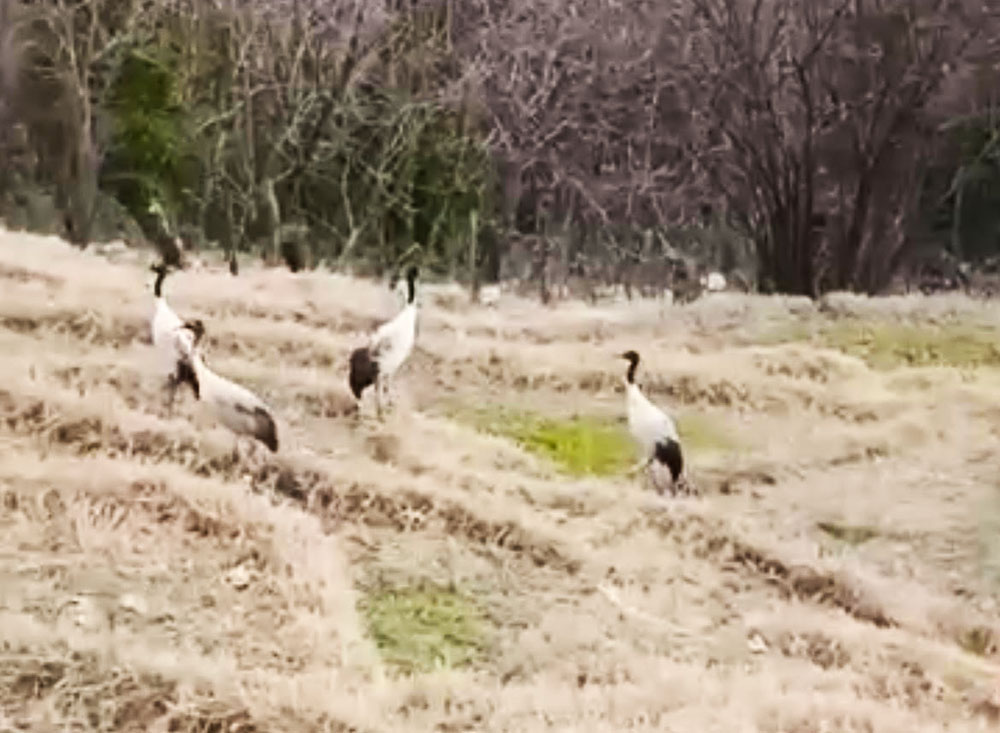Chencho Dema
Punakha—Historically, Punakha was a home for Black Necked Cranes. But now, these cranes are rarely seen there because their homes have been lost. However, in late February, four grown-up cranes were seen in the paddy fields of Sedchena village. This brought hope to the villagers that they might see more of these cranes in the future.
In the past, special places like Paro, Bajothang in Wangdue, and some parts of the Bumthang valley used to be homes for Black Necked Cranes. But now, these cranes do not live there anymore because their homes were lost due to development projects.
Lhab Tshering, the leader of Sedchena village, was surprised when he saw four Black Necked Cranes in the fields. He said they stayed there until the next day. This was unusual for the area, so he was very excited to see them and even took pictures of them with his phone.
In an interview with Kuensel, Jigme Tshering, who leads the Species Conservation Division (SCD) at the Royal Society for Protection of Nature (RSPN), mentioned that the cranes might have landed in Sedchena village because they were tired from flying long distances during their migration.
He said that during migration, crane groups with young birds often take short breaks for a day or two to rest and regain energy. This could explain why the cranes were seen in Sedchena village.
Sometimes, people spot the birds in Laya and Lunana.
He also said that sometimes people spot the cranes in Damji, Gasa, and Punakha, although it’s not very common.
The cranes usually come to Bhutan from Tibet between October and December and stay until the end of February. Then, they head back to Tibet by the end of February or the beginning of March. Their migration from Bhutan usually finishes by the third week of March.
In the past, Sonagasa in Punakha was a resting and feeding place for the birds. Similarly, Bajothang, which used to be paddy fields back in the 1980s but is now a town, was also a winter home for the birds. Furthermore, birds from Phobjikha used to fly to Bajothang during specific seasons.
He mentioned, “We often get calls from people all over the country reporting when they see the birds in their area. This shows that more people are becoming aware of them. But if the birds are seen regularly in one place, we talk with the local community to decide what to do next.”
Jigme Tshering mentioned that the birds follow three main migratory routes: one through Bumthang in central Bhutan, another through Khotokha and Phobjikha in West-Central Bhutan, and the third through Bomdelling, Trashiyangtse, and Lhuentse in the East.
There is internal migration from Bomdelling to Bumthang and Phobjikha. From Phobjikha, the cranes then migrate to Wangdue, Gasa, and Punakha.
The cranes from Phobjikha return to their summer home by flying over Duoqing Tsho, which is around 100 kilometers away from Phobjikha, crossing the border into Tibet. On the other hand, the cranes from Bomdelling fly through Ladhak, covering a distance of about 1000 kilometers. As for the cranes from Bumthang, their exact migration routes are still unknown because they haven’t been tagged by the Royal Society for Protection of Nature (RSPN). However, it is believed that they might follow the valley and Yellow River during their journey back.
The records kept by the RSPN since 1987 show a significant increase in the wintering population of Black Necked Cranes. In 1987, there were 370 cranes, and by 2023, the number had risen to 677. This marks a 12 percent increase from the previous year’s count of 599.
The rise in the number of birds can be credited to conservation efforts.
The migratory birds come to Bhutan every winter from their breeding grounds in Tibet.
The main wintering habitats for Black Necked Cranes in Bhutan are the valleys of Phobjikha in Wangdue Phodrang and Bumdeling in Trashiyangtse. Among these, Phobjikha has the largest population of cranes in the country.
According to the International Union for Conservation of Nature (IUCN), the Black-necked Crane is classified as ‘near threatened’. This means that the bird may be at risk of becoming endangered in the near future.


